Organizational Behavior and Leadership in 2M Group Limited
VerifiedAdded on 2020/06/04
|13
|4341
|41
Report
AI Summary
This report provides an in-depth analysis of organizational behavior within 2M Group Limited, focusing on how culture, power, and politics influence individual and team dynamics. It examines the impact of these factors on employee behavior and performance, particularly within the context of the chemical distribution and services industry. The report explores various motivational theories, including content and process theories, and evaluates their application in influencing employee behavior and achieving organizational goals. Furthermore, it delves into the characteristics of effective and ineffective teams, analyzing relevant team and group development theories to foster dynamic cooperation. The report concludes by applying concepts and philosophies of organizational behavior to 2M Group Limited, assessing their positive and negative influences on behavior and providing insights into improving leadership and team performance.
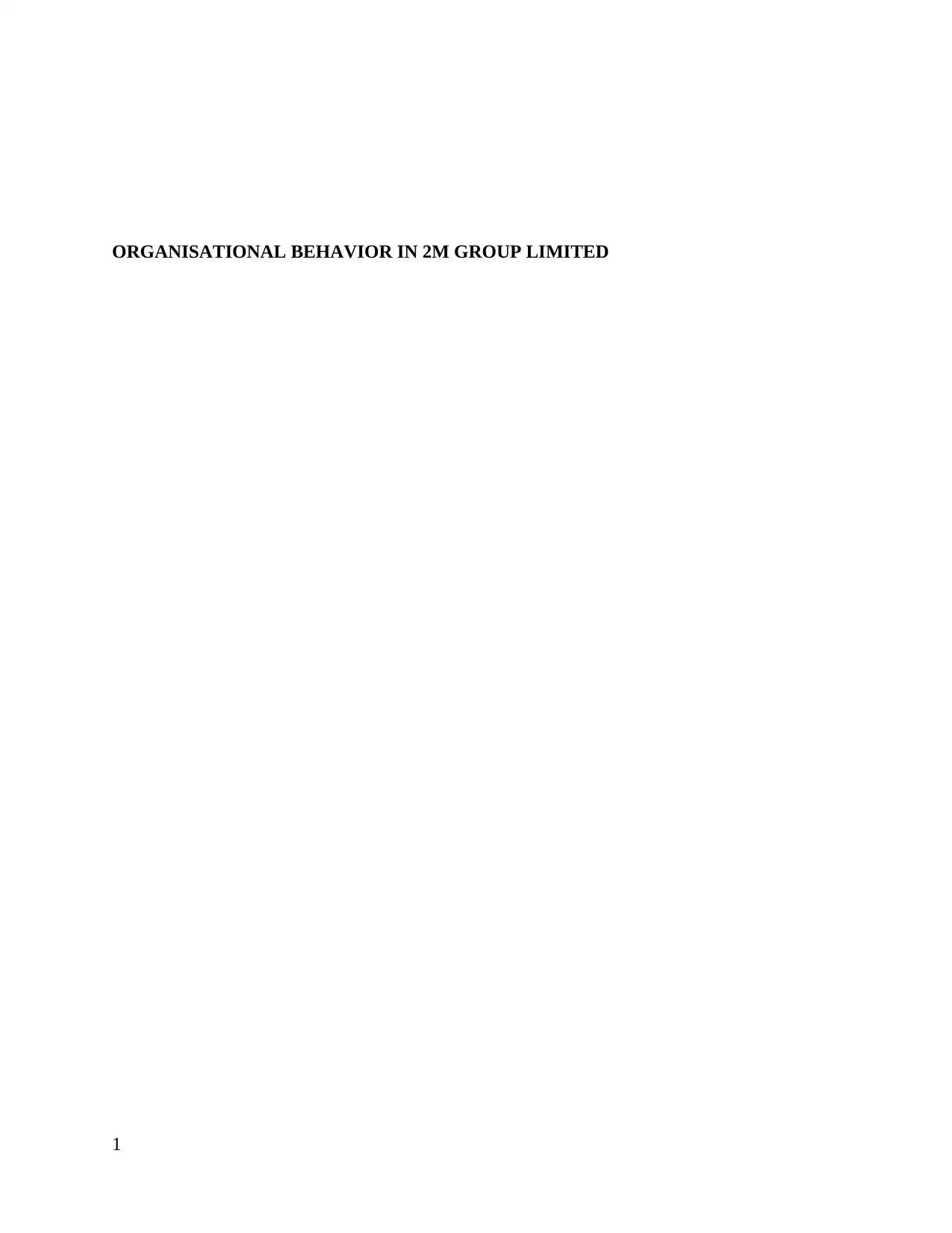
ORGANISATIONAL BEHAVIOR IN 2M GROUP LIMITED
1
1
Paraphrase This Document
Need a fresh take? Get an instant paraphrase of this document with our AI Paraphraser
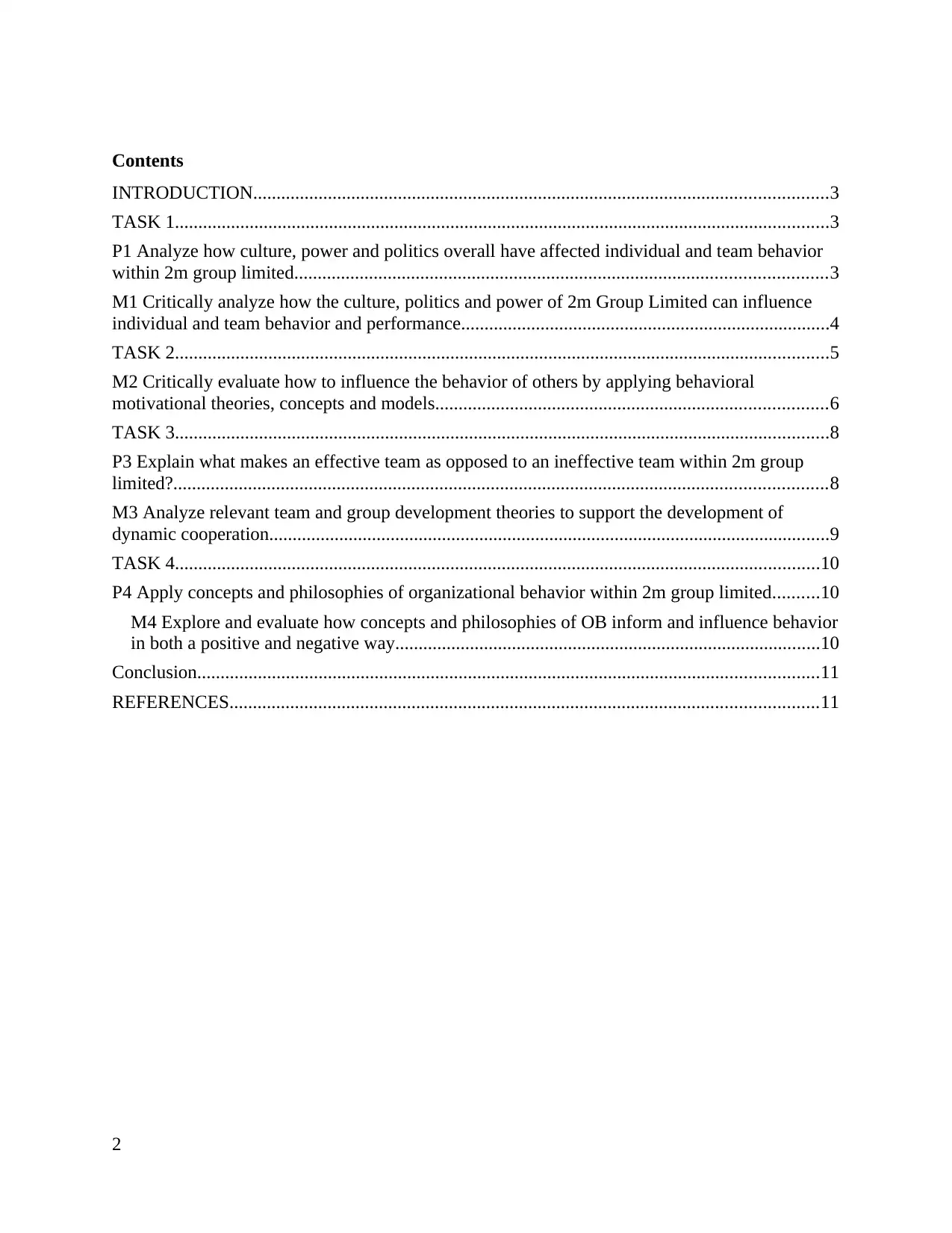
Contents
INTRODUCTION...........................................................................................................................3
TASK 1............................................................................................................................................3
P1 Analyze how culture, power and politics overall have affected individual and team behavior
within 2m group limited..................................................................................................................3
M1 Critically analyze how the culture, politics and power of 2m Group Limited can influence
individual and team behavior and performance...............................................................................4
TASK 2............................................................................................................................................5
M2 Critically evaluate how to influence the behavior of others by applying behavioral
motivational theories, concepts and models....................................................................................6
TASK 3............................................................................................................................................8
P3 Explain what makes an effective team as opposed to an ineffective team within 2m group
limited?............................................................................................................................................8
M3 Analyze relevant team and group development theories to support the development of
dynamic cooperation........................................................................................................................9
TASK 4..........................................................................................................................................10
P4 Apply concepts and philosophies of organizational behavior within 2m group limited..........10
M4 Explore and evaluate how concepts and philosophies of OB inform and influence behavior
in both a positive and negative way...........................................................................................10
Conclusion.....................................................................................................................................11
REFERENCES..............................................................................................................................11
2
INTRODUCTION...........................................................................................................................3
TASK 1............................................................................................................................................3
P1 Analyze how culture, power and politics overall have affected individual and team behavior
within 2m group limited..................................................................................................................3
M1 Critically analyze how the culture, politics and power of 2m Group Limited can influence
individual and team behavior and performance...............................................................................4
TASK 2............................................................................................................................................5
M2 Critically evaluate how to influence the behavior of others by applying behavioral
motivational theories, concepts and models....................................................................................6
TASK 3............................................................................................................................................8
P3 Explain what makes an effective team as opposed to an ineffective team within 2m group
limited?............................................................................................................................................8
M3 Analyze relevant team and group development theories to support the development of
dynamic cooperation........................................................................................................................9
TASK 4..........................................................................................................................................10
P4 Apply concepts and philosophies of organizational behavior within 2m group limited..........10
M4 Explore and evaluate how concepts and philosophies of OB inform and influence behavior
in both a positive and negative way...........................................................................................10
Conclusion.....................................................................................................................................11
REFERENCES..............................................................................................................................11
2
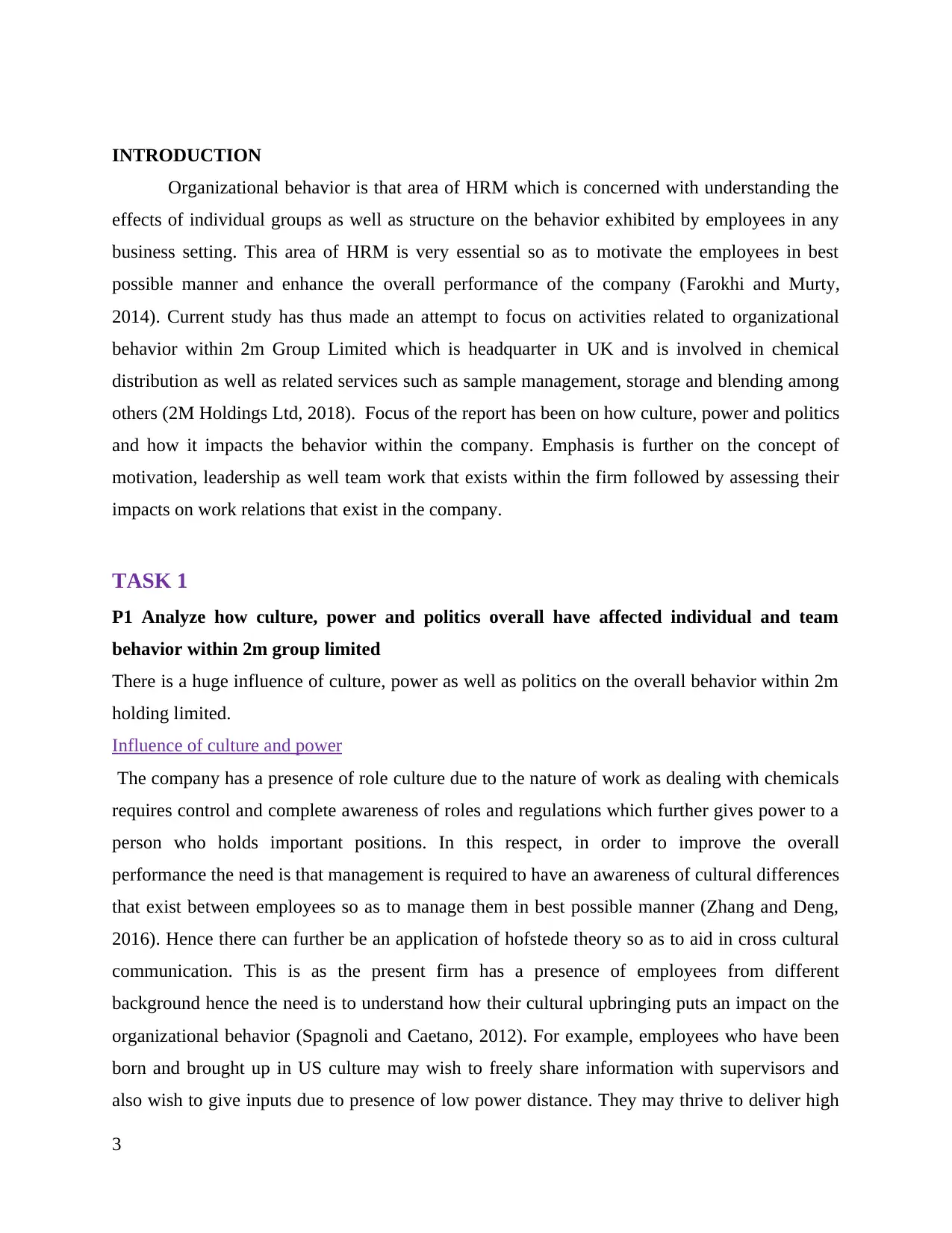
INTRODUCTION
Organizational behavior is that area of HRM which is concerned with understanding the
effects of individual groups as well as structure on the behavior exhibited by employees in any
business setting. This area of HRM is very essential so as to motivate the employees in best
possible manner and enhance the overall performance of the company (Farokhi and Murty,
2014). Current study has thus made an attempt to focus on activities related to organizational
behavior within 2m Group Limited which is headquarter in UK and is involved in chemical
distribution as well as related services such as sample management, storage and blending among
others (2M Holdings Ltd, 2018). Focus of the report has been on how culture, power and politics
and how it impacts the behavior within the company. Emphasis is further on the concept of
motivation, leadership as well team work that exists within the firm followed by assessing their
impacts on work relations that exist in the company.
TASK 1
P1 Analyze how culture, power and politics overall have affected individual and team
behavior within 2m group limited
There is a huge influence of culture, power as well as politics on the overall behavior within 2m
holding limited.
Influence of culture and power
The company has a presence of role culture due to the nature of work as dealing with chemicals
requires control and complete awareness of roles and regulations which further gives power to a
person who holds important positions. In this respect, in order to improve the overall
performance the need is that management is required to have an awareness of cultural differences
that exist between employees so as to manage them in best possible manner (Zhang and Deng,
2016). Hence there can further be an application of hofstede theory so as to aid in cross cultural
communication. This is as the present firm has a presence of employees from different
background hence the need is to understand how their cultural upbringing puts an impact on the
organizational behavior (Spagnoli and Caetano, 2012). For example, employees who have been
born and brought up in US culture may wish to freely share information with supervisors and
also wish to give inputs due to presence of low power distance. They may thrive to deliver high
3
Organizational behavior is that area of HRM which is concerned with understanding the
effects of individual groups as well as structure on the behavior exhibited by employees in any
business setting. This area of HRM is very essential so as to motivate the employees in best
possible manner and enhance the overall performance of the company (Farokhi and Murty,
2014). Current study has thus made an attempt to focus on activities related to organizational
behavior within 2m Group Limited which is headquarter in UK and is involved in chemical
distribution as well as related services such as sample management, storage and blending among
others (2M Holdings Ltd, 2018). Focus of the report has been on how culture, power and politics
and how it impacts the behavior within the company. Emphasis is further on the concept of
motivation, leadership as well team work that exists within the firm followed by assessing their
impacts on work relations that exist in the company.
TASK 1
P1 Analyze how culture, power and politics overall have affected individual and team
behavior within 2m group limited
There is a huge influence of culture, power as well as politics on the overall behavior within 2m
holding limited.
Influence of culture and power
The company has a presence of role culture due to the nature of work as dealing with chemicals
requires control and complete awareness of roles and regulations which further gives power to a
person who holds important positions. In this respect, in order to improve the overall
performance the need is that management is required to have an awareness of cultural differences
that exist between employees so as to manage them in best possible manner (Zhang and Deng,
2016). Hence there can further be an application of hofstede theory so as to aid in cross cultural
communication. This is as the present firm has a presence of employees from different
background hence the need is to understand how their cultural upbringing puts an impact on the
organizational behavior (Spagnoli and Caetano, 2012). For example, employees who have been
born and brought up in US culture may wish to freely share information with supervisors and
also wish to give inputs due to presence of low power distance. They may thrive to deliver high
3
⊘ This is a preview!⊘
Do you want full access?
Subscribe today to unlock all pages.

Trusted by 1+ million students worldwide
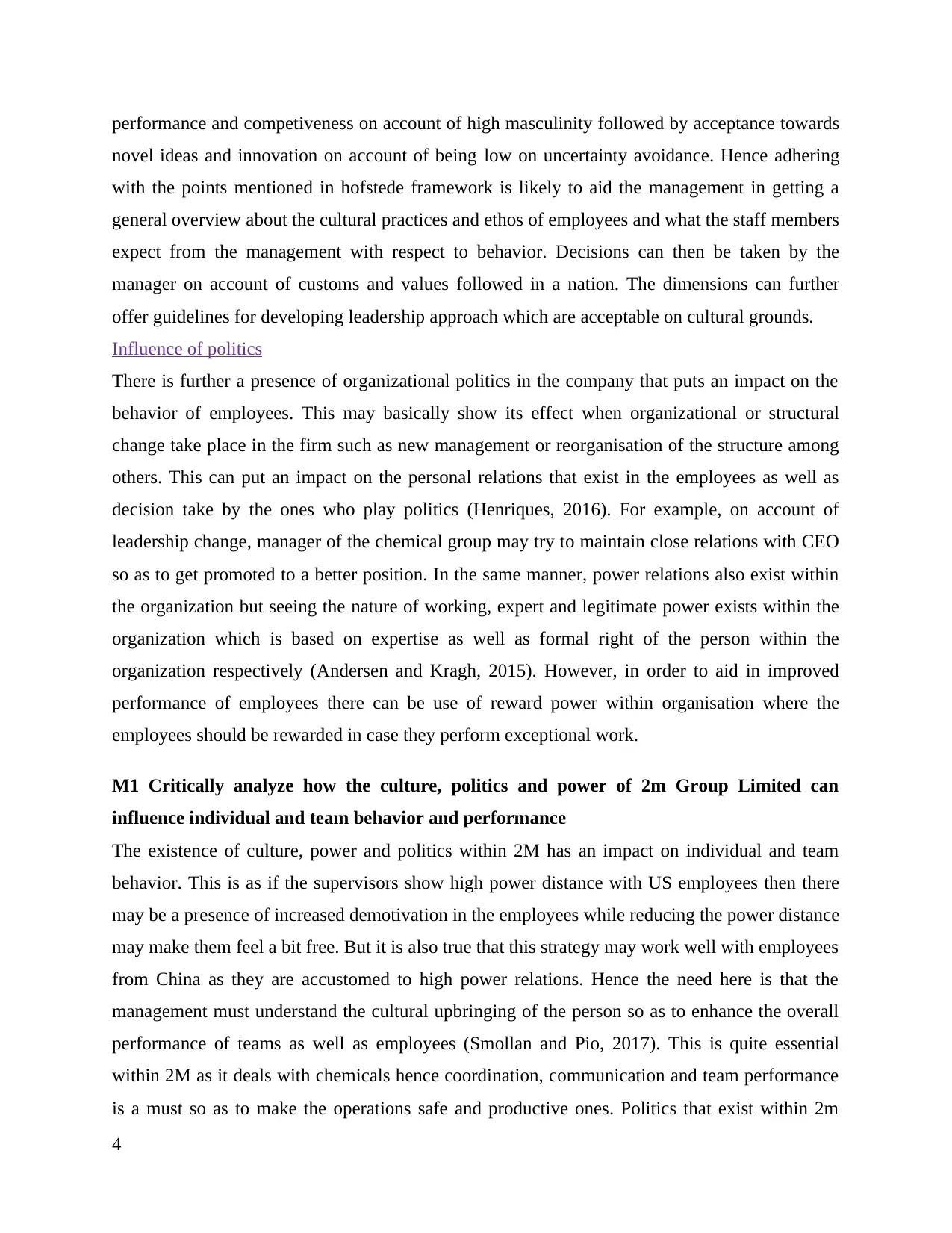
performance and competiveness on account of high masculinity followed by acceptance towards
novel ideas and innovation on account of being low on uncertainty avoidance. Hence adhering
with the points mentioned in hofstede framework is likely to aid the management in getting a
general overview about the cultural practices and ethos of employees and what the staff members
expect from the management with respect to behavior. Decisions can then be taken by the
manager on account of customs and values followed in a nation. The dimensions can further
offer guidelines for developing leadership approach which are acceptable on cultural grounds.
Influence of politics
There is further a presence of organizational politics in the company that puts an impact on the
behavior of employees. This may basically show its effect when organizational or structural
change take place in the firm such as new management or reorganisation of the structure among
others. This can put an impact on the personal relations that exist in the employees as well as
decision take by the ones who play politics (Henriques, 2016). For example, on account of
leadership change, manager of the chemical group may try to maintain close relations with CEO
so as to get promoted to a better position. In the same manner, power relations also exist within
the organization but seeing the nature of working, expert and legitimate power exists within the
organization which is based on expertise as well as formal right of the person within the
organization respectively (Andersen and Kragh, 2015). However, in order to aid in improved
performance of employees there can be use of reward power within organisation where the
employees should be rewarded in case they perform exceptional work.
M1 Critically analyze how the culture, politics and power of 2m Group Limited can
influence individual and team behavior and performance
The existence of culture, power and politics within 2M has an impact on individual and team
behavior. This is as if the supervisors show high power distance with US employees then there
may be a presence of increased demotivation in the employees while reducing the power distance
may make them feel a bit free. But it is also true that this strategy may work well with employees
from China as they are accustomed to high power relations. Hence the need here is that the
management must understand the cultural upbringing of the person so as to enhance the overall
performance of teams as well as employees (Smollan and Pio, 2017). This is quite essential
within 2M as it deals with chemicals hence coordination, communication and team performance
is a must so as to make the operations safe and productive ones. Politics that exist within 2m
4
novel ideas and innovation on account of being low on uncertainty avoidance. Hence adhering
with the points mentioned in hofstede framework is likely to aid the management in getting a
general overview about the cultural practices and ethos of employees and what the staff members
expect from the management with respect to behavior. Decisions can then be taken by the
manager on account of customs and values followed in a nation. The dimensions can further
offer guidelines for developing leadership approach which are acceptable on cultural grounds.
Influence of politics
There is further a presence of organizational politics in the company that puts an impact on the
behavior of employees. This may basically show its effect when organizational or structural
change take place in the firm such as new management or reorganisation of the structure among
others. This can put an impact on the personal relations that exist in the employees as well as
decision take by the ones who play politics (Henriques, 2016). For example, on account of
leadership change, manager of the chemical group may try to maintain close relations with CEO
so as to get promoted to a better position. In the same manner, power relations also exist within
the organization but seeing the nature of working, expert and legitimate power exists within the
organization which is based on expertise as well as formal right of the person within the
organization respectively (Andersen and Kragh, 2015). However, in order to aid in improved
performance of employees there can be use of reward power within organisation where the
employees should be rewarded in case they perform exceptional work.
M1 Critically analyze how the culture, politics and power of 2m Group Limited can
influence individual and team behavior and performance
The existence of culture, power and politics within 2M has an impact on individual and team
behavior. This is as if the supervisors show high power distance with US employees then there
may be a presence of increased demotivation in the employees while reducing the power distance
may make them feel a bit free. But it is also true that this strategy may work well with employees
from China as they are accustomed to high power relations. Hence the need here is that the
management must understand the cultural upbringing of the person so as to enhance the overall
performance of teams as well as employees (Smollan and Pio, 2017). This is quite essential
within 2M as it deals with chemicals hence coordination, communication and team performance
is a must so as to make the operations safe and productive ones. Politics that exist within 2m
4
Paraphrase This Document
Need a fresh take? Get an instant paraphrase of this document with our AI Paraphraser
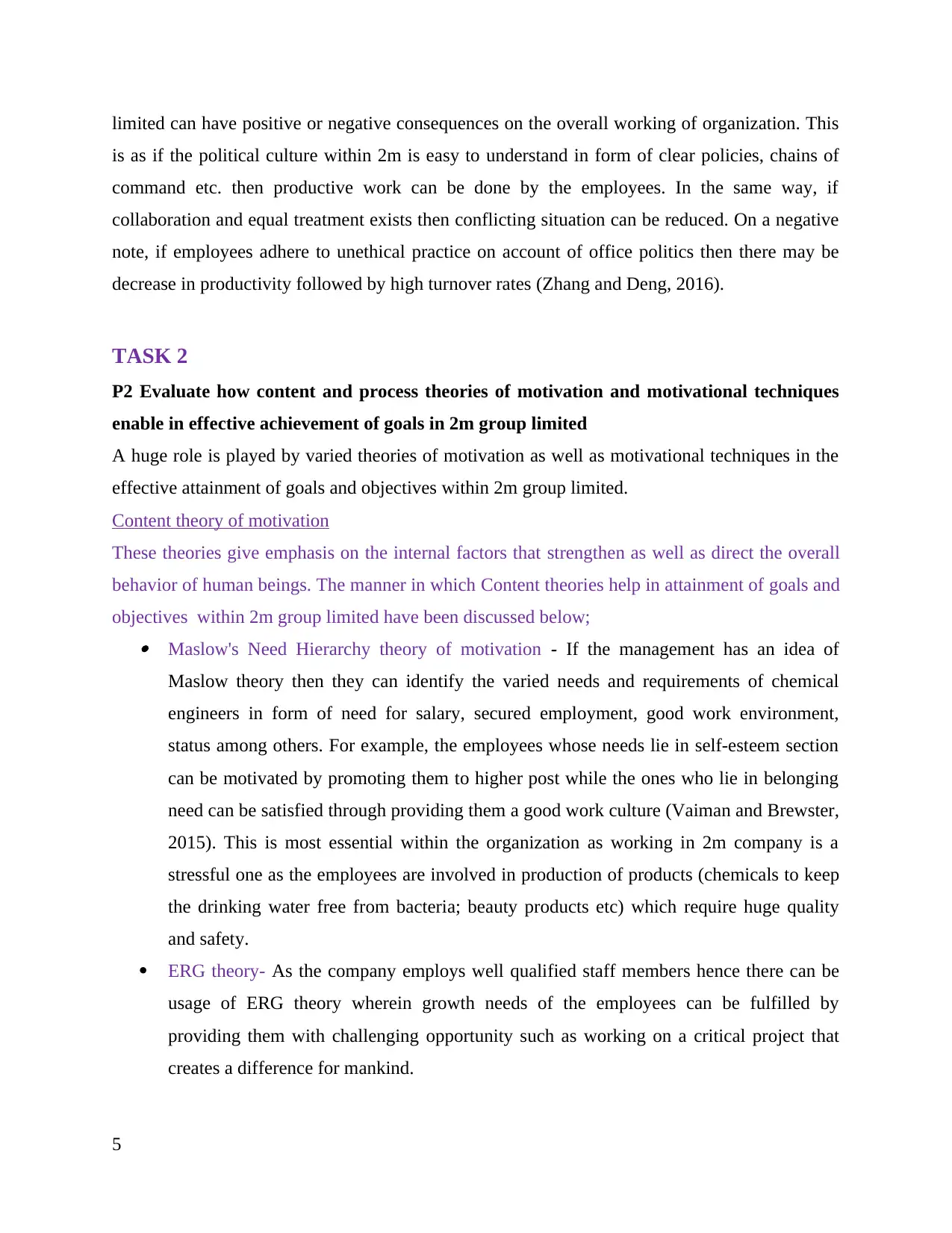
limited can have positive or negative consequences on the overall working of organization. This
is as if the political culture within 2m is easy to understand in form of clear policies, chains of
command etc. then productive work can be done by the employees. In the same way, if
collaboration and equal treatment exists then conflicting situation can be reduced. On a negative
note, if employees adhere to unethical practice on account of office politics then there may be
decrease in productivity followed by high turnover rates (Zhang and Deng, 2016).
TASK 2
P2 Evaluate how content and process theories of motivation and motivational techniques
enable in effective achievement of goals in 2m group limited
A huge role is played by varied theories of motivation as well as motivational techniques in the
effective attainment of goals and objectives within 2m group limited.
Content theory of motivation
These theories give emphasis on the internal factors that strengthen as well as direct the overall
behavior of human beings. The manner in which Content theories help in attainment of goals and
objectives within 2m group limited have been discussed below; Maslow's Need Hierarchy theory of motivation - If the management has an idea of
Maslow theory then they can identify the varied needs and requirements of chemical
engineers in form of need for salary, secured employment, good work environment,
status among others. For example, the employees whose needs lie in self-esteem section
can be motivated by promoting them to higher post while the ones who lie in belonging
need can be satisfied through providing them a good work culture (Vaiman and Brewster,
2015). This is most essential within the organization as working in 2m company is a
stressful one as the employees are involved in production of products (chemicals to keep
the drinking water free from bacteria; beauty products etc) which require huge quality
and safety.
ERG theory- As the company employs well qualified staff members hence there can be
usage of ERG theory wherein growth needs of the employees can be fulfilled by
providing them with challenging opportunity such as working on a critical project that
creates a difference for mankind.
5
is as if the political culture within 2m is easy to understand in form of clear policies, chains of
command etc. then productive work can be done by the employees. In the same way, if
collaboration and equal treatment exists then conflicting situation can be reduced. On a negative
note, if employees adhere to unethical practice on account of office politics then there may be
decrease in productivity followed by high turnover rates (Zhang and Deng, 2016).
TASK 2
P2 Evaluate how content and process theories of motivation and motivational techniques
enable in effective achievement of goals in 2m group limited
A huge role is played by varied theories of motivation as well as motivational techniques in the
effective attainment of goals and objectives within 2m group limited.
Content theory of motivation
These theories give emphasis on the internal factors that strengthen as well as direct the overall
behavior of human beings. The manner in which Content theories help in attainment of goals and
objectives within 2m group limited have been discussed below; Maslow's Need Hierarchy theory of motivation - If the management has an idea of
Maslow theory then they can identify the varied needs and requirements of chemical
engineers in form of need for salary, secured employment, good work environment,
status among others. For example, the employees whose needs lie in self-esteem section
can be motivated by promoting them to higher post while the ones who lie in belonging
need can be satisfied through providing them a good work culture (Vaiman and Brewster,
2015). This is most essential within the organization as working in 2m company is a
stressful one as the employees are involved in production of products (chemicals to keep
the drinking water free from bacteria; beauty products etc) which require huge quality
and safety.
ERG theory- As the company employs well qualified staff members hence there can be
usage of ERG theory wherein growth needs of the employees can be fulfilled by
providing them with challenging opportunity such as working on a critical project that
creates a difference for mankind.
5
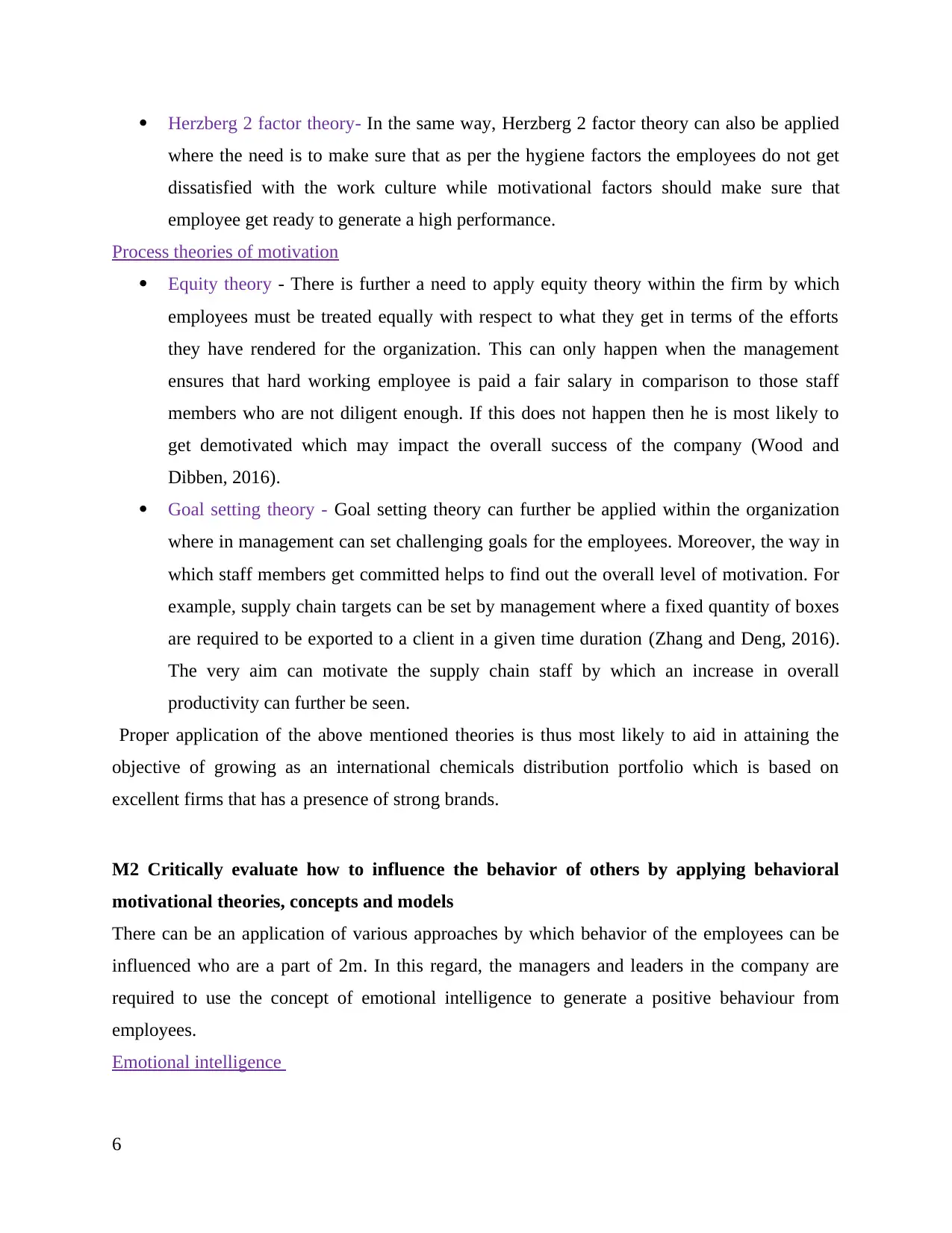
Herzberg 2 factor theory- In the same way, Herzberg 2 factor theory can also be applied
where the need is to make sure that as per the hygiene factors the employees do not get
dissatisfied with the work culture while motivational factors should make sure that
employee get ready to generate a high performance.
Process theories of motivation
Equity theory - There is further a need to apply equity theory within the firm by which
employees must be treated equally with respect to what they get in terms of the efforts
they have rendered for the organization. This can only happen when the management
ensures that hard working employee is paid a fair salary in comparison to those staff
members who are not diligent enough. If this does not happen then he is most likely to
get demotivated which may impact the overall success of the company (Wood and
Dibben, 2016).
Goal setting theory - Goal setting theory can further be applied within the organization
where in management can set challenging goals for the employees. Moreover, the way in
which staff members get committed helps to find out the overall level of motivation. For
example, supply chain targets can be set by management where a fixed quantity of boxes
are required to be exported to a client in a given time duration (Zhang and Deng, 2016).
The very aim can motivate the supply chain staff by which an increase in overall
productivity can further be seen.
Proper application of the above mentioned theories is thus most likely to aid in attaining the
objective of growing as an international chemicals distribution portfolio which is based on
excellent firms that has a presence of strong brands.
M2 Critically evaluate how to influence the behavior of others by applying behavioral
motivational theories, concepts and models
There can be an application of various approaches by which behavior of the employees can be
influenced who are a part of 2m. In this regard, the managers and leaders in the company are
required to use the concept of emotional intelligence to generate a positive behaviour from
employees.
Emotional intelligence
6
where the need is to make sure that as per the hygiene factors the employees do not get
dissatisfied with the work culture while motivational factors should make sure that
employee get ready to generate a high performance.
Process theories of motivation
Equity theory - There is further a need to apply equity theory within the firm by which
employees must be treated equally with respect to what they get in terms of the efforts
they have rendered for the organization. This can only happen when the management
ensures that hard working employee is paid a fair salary in comparison to those staff
members who are not diligent enough. If this does not happen then he is most likely to
get demotivated which may impact the overall success of the company (Wood and
Dibben, 2016).
Goal setting theory - Goal setting theory can further be applied within the organization
where in management can set challenging goals for the employees. Moreover, the way in
which staff members get committed helps to find out the overall level of motivation. For
example, supply chain targets can be set by management where a fixed quantity of boxes
are required to be exported to a client in a given time duration (Zhang and Deng, 2016).
The very aim can motivate the supply chain staff by which an increase in overall
productivity can further be seen.
Proper application of the above mentioned theories is thus most likely to aid in attaining the
objective of growing as an international chemicals distribution portfolio which is based on
excellent firms that has a presence of strong brands.
M2 Critically evaluate how to influence the behavior of others by applying behavioral
motivational theories, concepts and models
There can be an application of various approaches by which behavior of the employees can be
influenced who are a part of 2m. In this regard, the managers and leaders in the company are
required to use the concept of emotional intelligence to generate a positive behaviour from
employees.
Emotional intelligence
6
⊘ This is a preview!⊘
Do you want full access?
Subscribe today to unlock all pages.

Trusted by 1+ million students worldwide
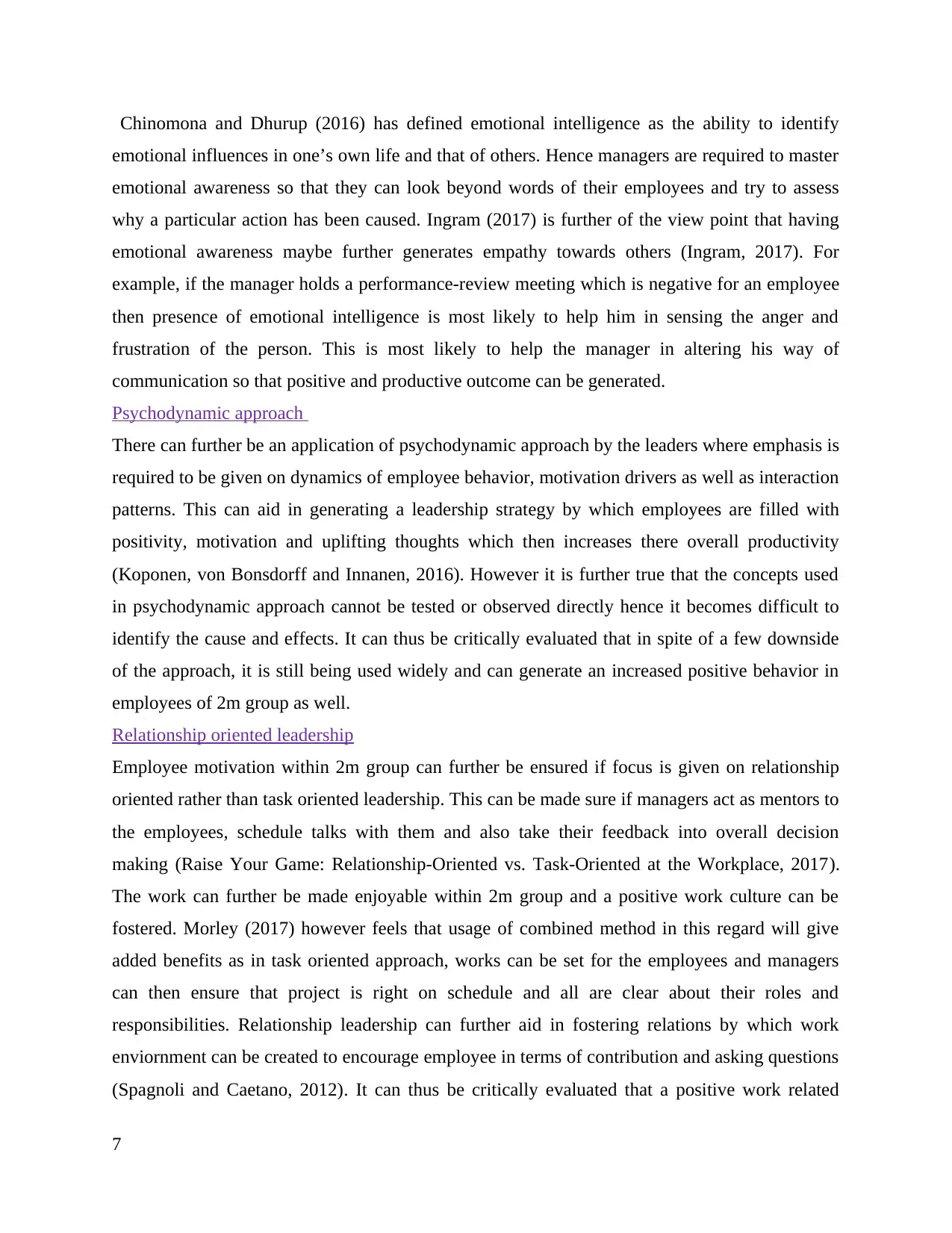
Chinomona and Dhurup (2016) has defined emotional intelligence as the ability to identify
emotional influences in one’s own life and that of others. Hence managers are required to master
emotional awareness so that they can look beyond words of their employees and try to assess
why a particular action has been caused. Ingram (2017) is further of the view point that having
emotional awareness maybe further generates empathy towards others (Ingram, 2017). For
example, if the manager holds a performance-review meeting which is negative for an employee
then presence of emotional intelligence is most likely to help him in sensing the anger and
frustration of the person. This is most likely to help the manager in altering his way of
communication so that positive and productive outcome can be generated.
Psychodynamic approach
There can further be an application of psychodynamic approach by the leaders where emphasis is
required to be given on dynamics of employee behavior, motivation drivers as well as interaction
patterns. This can aid in generating a leadership strategy by which employees are filled with
positivity, motivation and uplifting thoughts which then increases there overall productivity
(Koponen, von Bonsdorff and Innanen, 2016). However it is further true that the concepts used
in psychodynamic approach cannot be tested or observed directly hence it becomes difficult to
identify the cause and effects. It can thus be critically evaluated that in spite of a few downside
of the approach, it is still being used widely and can generate an increased positive behavior in
employees of 2m group as well.
Relationship oriented leadership
Employee motivation within 2m group can further be ensured if focus is given on relationship
oriented rather than task oriented leadership. This can be made sure if managers act as mentors to
the employees, schedule talks with them and also take their feedback into overall decision
making (Raise Your Game: Relationship-Oriented vs. Task-Oriented at the Workplace, 2017).
The work can further be made enjoyable within 2m group and a positive work culture can be
fostered. Morley (2017) however feels that usage of combined method in this regard will give
added benefits as in task oriented approach, works can be set for the employees and managers
can then ensure that project is right on schedule and all are clear about their roles and
responsibilities. Relationship leadership can further aid in fostering relations by which work
enviornment can be created to encourage employee in terms of contribution and asking questions
(Spagnoli and Caetano, 2012). It can thus be critically evaluated that a positive work related
7
emotional influences in one’s own life and that of others. Hence managers are required to master
emotional awareness so that they can look beyond words of their employees and try to assess
why a particular action has been caused. Ingram (2017) is further of the view point that having
emotional awareness maybe further generates empathy towards others (Ingram, 2017). For
example, if the manager holds a performance-review meeting which is negative for an employee
then presence of emotional intelligence is most likely to help him in sensing the anger and
frustration of the person. This is most likely to help the manager in altering his way of
communication so that positive and productive outcome can be generated.
Psychodynamic approach
There can further be an application of psychodynamic approach by the leaders where emphasis is
required to be given on dynamics of employee behavior, motivation drivers as well as interaction
patterns. This can aid in generating a leadership strategy by which employees are filled with
positivity, motivation and uplifting thoughts which then increases there overall productivity
(Koponen, von Bonsdorff and Innanen, 2016). However it is further true that the concepts used
in psychodynamic approach cannot be tested or observed directly hence it becomes difficult to
identify the cause and effects. It can thus be critically evaluated that in spite of a few downside
of the approach, it is still being used widely and can generate an increased positive behavior in
employees of 2m group as well.
Relationship oriented leadership
Employee motivation within 2m group can further be ensured if focus is given on relationship
oriented rather than task oriented leadership. This can be made sure if managers act as mentors to
the employees, schedule talks with them and also take their feedback into overall decision
making (Raise Your Game: Relationship-Oriented vs. Task-Oriented at the Workplace, 2017).
The work can further be made enjoyable within 2m group and a positive work culture can be
fostered. Morley (2017) however feels that usage of combined method in this regard will give
added benefits as in task oriented approach, works can be set for the employees and managers
can then ensure that project is right on schedule and all are clear about their roles and
responsibilities. Relationship leadership can further aid in fostering relations by which work
enviornment can be created to encourage employee in terms of contribution and asking questions
(Spagnoli and Caetano, 2012). It can thus be critically evaluated that a positive work related
7
Paraphrase This Document
Need a fresh take? Get an instant paraphrase of this document with our AI Paraphraser
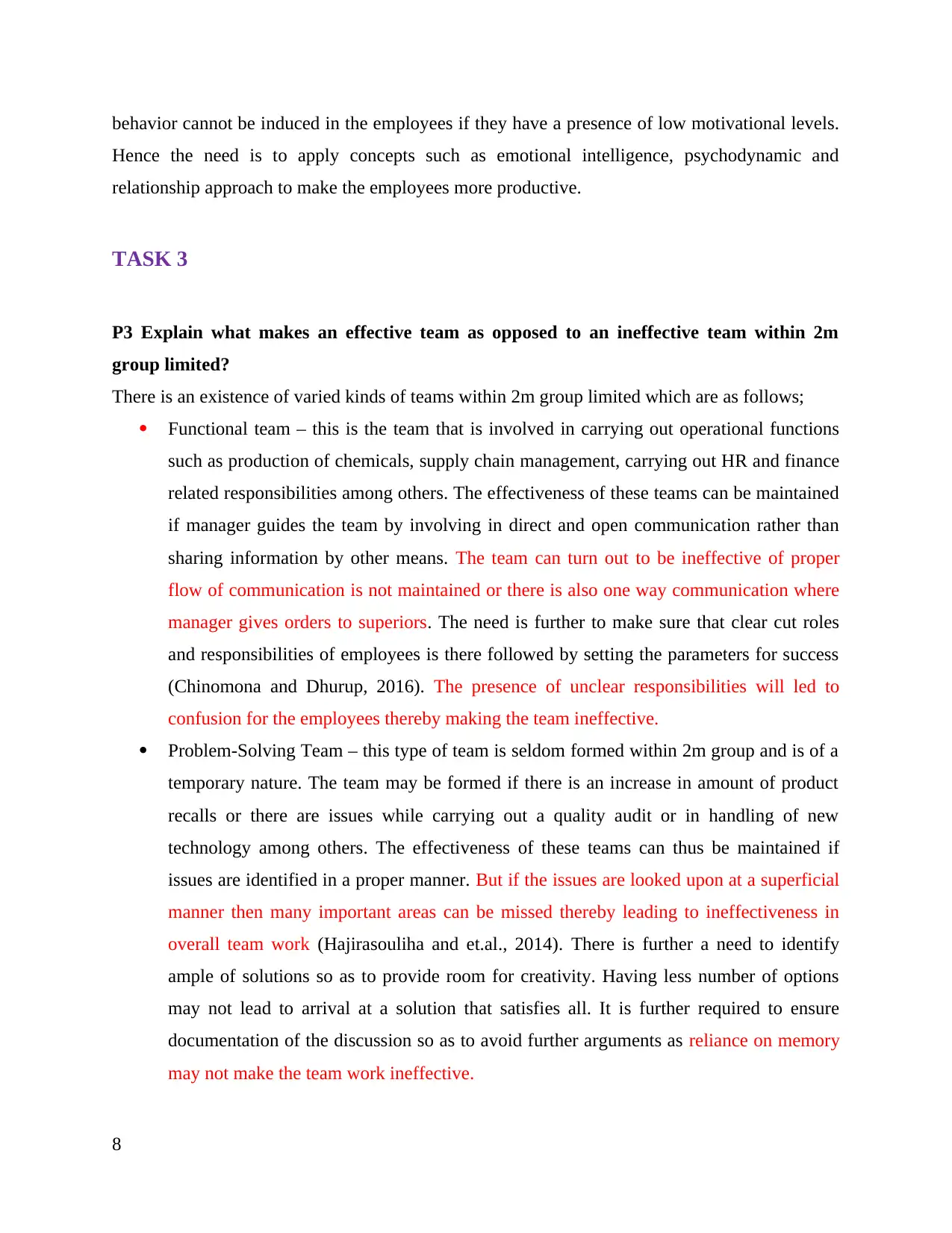
behavior cannot be induced in the employees if they have a presence of low motivational levels.
Hence the need is to apply concepts such as emotional intelligence, psychodynamic and
relationship approach to make the employees more productive.
TASK 3
P3 Explain what makes an effective team as opposed to an ineffective team within 2m
group limited?
There is an existence of varied kinds of teams within 2m group limited which are as follows;
Functional team – this is the team that is involved in carrying out operational functions
such as production of chemicals, supply chain management, carrying out HR and finance
related responsibilities among others. The effectiveness of these teams can be maintained
if manager guides the team by involving in direct and open communication rather than
sharing information by other means. The team can turn out to be ineffective of proper
flow of communication is not maintained or there is also one way communication where
manager gives orders to superiors. The need is further to make sure that clear cut roles
and responsibilities of employees is there followed by setting the parameters for success
(Chinomona and Dhurup, 2016). The presence of unclear responsibilities will led to
confusion for the employees thereby making the team ineffective.
Problem-Solving Team – this type of team is seldom formed within 2m group and is of a
temporary nature. The team may be formed if there is an increase in amount of product
recalls or there are issues while carrying out a quality audit or in handling of new
technology among others. The effectiveness of these teams can thus be maintained if
issues are identified in a proper manner. But if the issues are looked upon at a superficial
manner then many important areas can be missed thereby leading to ineffectiveness in
overall team work (Hajirasouliha and et.al., 2014). There is further a need to identify
ample of solutions so as to provide room for creativity. Having less number of options
may not lead to arrival at a solution that satisfies all. It is further required to ensure
documentation of the discussion so as to avoid further arguments as reliance on memory
may not make the team work ineffective.
8
Hence the need is to apply concepts such as emotional intelligence, psychodynamic and
relationship approach to make the employees more productive.
TASK 3
P3 Explain what makes an effective team as opposed to an ineffective team within 2m
group limited?
There is an existence of varied kinds of teams within 2m group limited which are as follows;
Functional team – this is the team that is involved in carrying out operational functions
such as production of chemicals, supply chain management, carrying out HR and finance
related responsibilities among others. The effectiveness of these teams can be maintained
if manager guides the team by involving in direct and open communication rather than
sharing information by other means. The team can turn out to be ineffective of proper
flow of communication is not maintained or there is also one way communication where
manager gives orders to superiors. The need is further to make sure that clear cut roles
and responsibilities of employees is there followed by setting the parameters for success
(Chinomona and Dhurup, 2016). The presence of unclear responsibilities will led to
confusion for the employees thereby making the team ineffective.
Problem-Solving Team – this type of team is seldom formed within 2m group and is of a
temporary nature. The team may be formed if there is an increase in amount of product
recalls or there are issues while carrying out a quality audit or in handling of new
technology among others. The effectiveness of these teams can thus be maintained if
issues are identified in a proper manner. But if the issues are looked upon at a superficial
manner then many important areas can be missed thereby leading to ineffectiveness in
overall team work (Hajirasouliha and et.al., 2014). There is further a need to identify
ample of solutions so as to provide room for creativity. Having less number of options
may not lead to arrival at a solution that satisfies all. It is further required to ensure
documentation of the discussion so as to avoid further arguments as reliance on memory
may not make the team work ineffective.
8
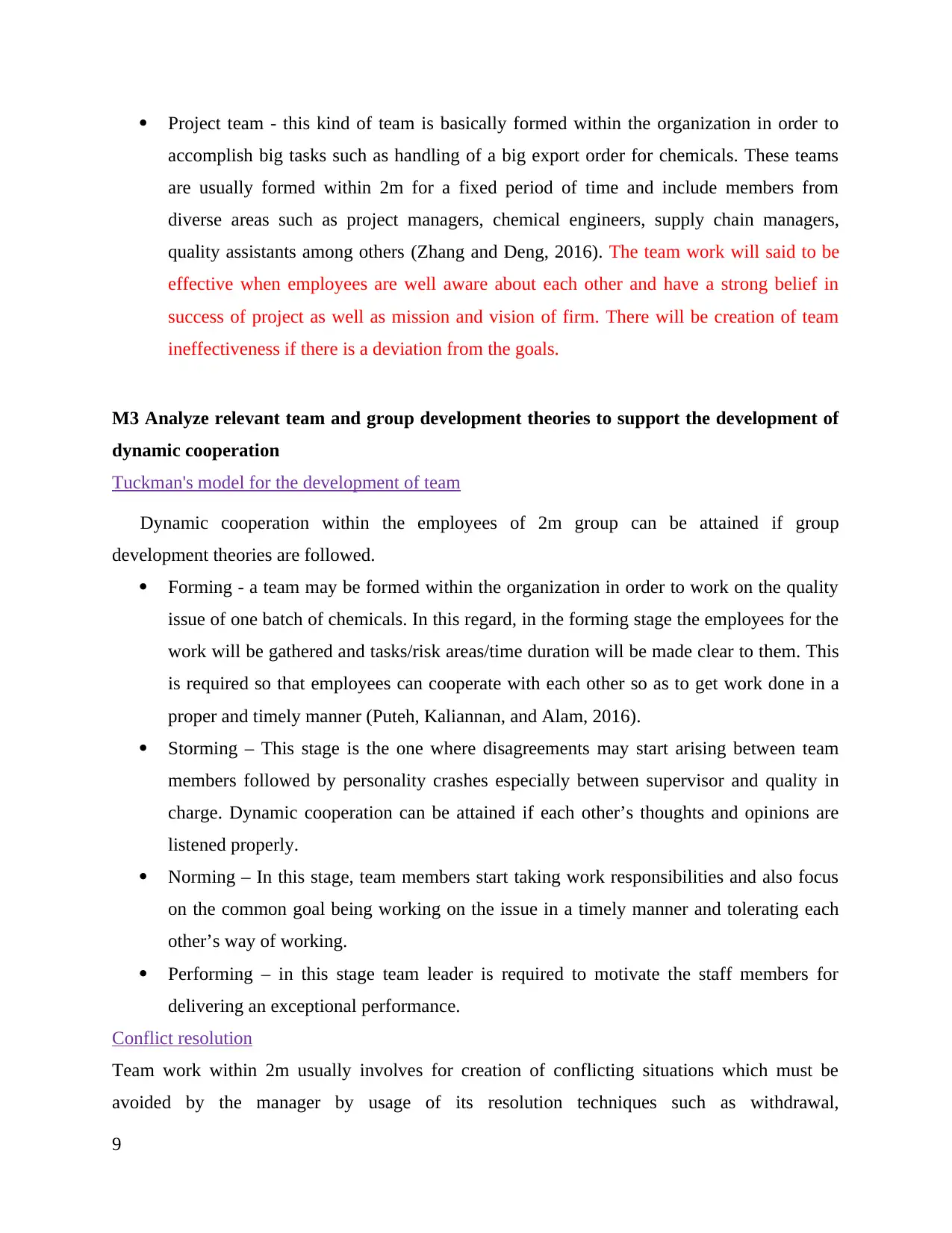
Project team - this kind of team is basically formed within the organization in order to
accomplish big tasks such as handling of a big export order for chemicals. These teams
are usually formed within 2m for a fixed period of time and include members from
diverse areas such as project managers, chemical engineers, supply chain managers,
quality assistants among others (Zhang and Deng, 2016). The team work will said to be
effective when employees are well aware about each other and have a strong belief in
success of project as well as mission and vision of firm. There will be creation of team
ineffectiveness if there is a deviation from the goals.
M3 Analyze relevant team and group development theories to support the development of
dynamic cooperation
Tuckman's model for the development of team
Dynamic cooperation within the employees of 2m group can be attained if group
development theories are followed.
Forming - a team may be formed within the organization in order to work on the quality
issue of one batch of chemicals. In this regard, in the forming stage the employees for the
work will be gathered and tasks/risk areas/time duration will be made clear to them. This
is required so that employees can cooperate with each other so as to get work done in a
proper and timely manner (Puteh, Kaliannan, and Alam, 2016).
Storming – This stage is the one where disagreements may start arising between team
members followed by personality crashes especially between supervisor and quality in
charge. Dynamic cooperation can be attained if each other’s thoughts and opinions are
listened properly.
Norming – In this stage, team members start taking work responsibilities and also focus
on the common goal being working on the issue in a timely manner and tolerating each
other’s way of working.
Performing – in this stage team leader is required to motivate the staff members for
delivering an exceptional performance.
Conflict resolution
Team work within 2m usually involves for creation of conflicting situations which must be
avoided by the manager by usage of its resolution techniques such as withdrawal,
9
accomplish big tasks such as handling of a big export order for chemicals. These teams
are usually formed within 2m for a fixed period of time and include members from
diverse areas such as project managers, chemical engineers, supply chain managers,
quality assistants among others (Zhang and Deng, 2016). The team work will said to be
effective when employees are well aware about each other and have a strong belief in
success of project as well as mission and vision of firm. There will be creation of team
ineffectiveness if there is a deviation from the goals.
M3 Analyze relevant team and group development theories to support the development of
dynamic cooperation
Tuckman's model for the development of team
Dynamic cooperation within the employees of 2m group can be attained if group
development theories are followed.
Forming - a team may be formed within the organization in order to work on the quality
issue of one batch of chemicals. In this regard, in the forming stage the employees for the
work will be gathered and tasks/risk areas/time duration will be made clear to them. This
is required so that employees can cooperate with each other so as to get work done in a
proper and timely manner (Puteh, Kaliannan, and Alam, 2016).
Storming – This stage is the one where disagreements may start arising between team
members followed by personality crashes especially between supervisor and quality in
charge. Dynamic cooperation can be attained if each other’s thoughts and opinions are
listened properly.
Norming – In this stage, team members start taking work responsibilities and also focus
on the common goal being working on the issue in a timely manner and tolerating each
other’s way of working.
Performing – in this stage team leader is required to motivate the staff members for
delivering an exceptional performance.
Conflict resolution
Team work within 2m usually involves for creation of conflicting situations which must be
avoided by the manager by usage of its resolution techniques such as withdrawal,
9
⊘ This is a preview!⊘
Do you want full access?
Subscribe today to unlock all pages.

Trusted by 1+ million students worldwide
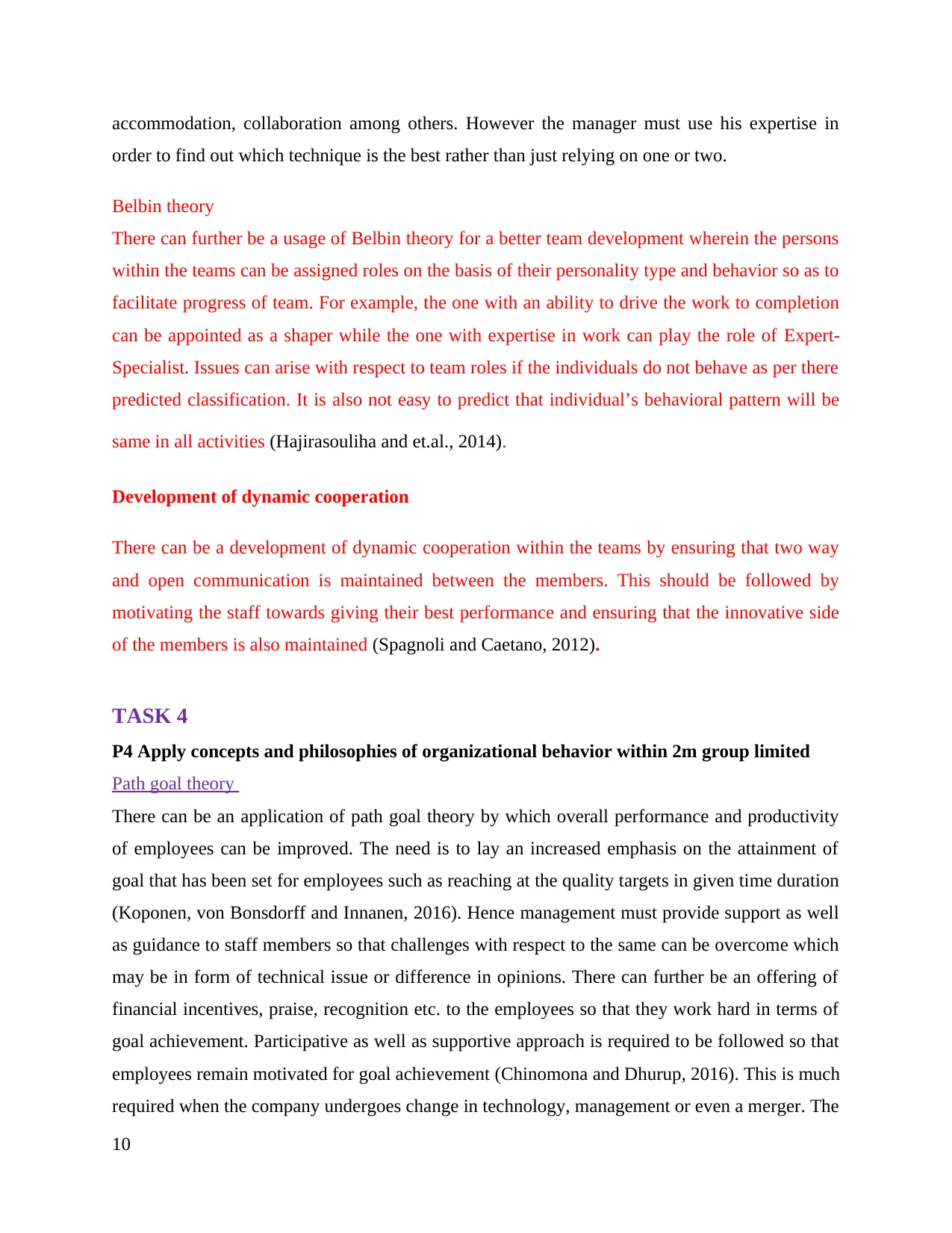
accommodation, collaboration among others. However the manager must use his expertise in
order to find out which technique is the best rather than just relying on one or two.
Belbin theory
There can further be a usage of Belbin theory for a better team development wherein the persons
within the teams can be assigned roles on the basis of their personality type and behavior so as to
facilitate progress of team. For example, the one with an ability to drive the work to completion
can be appointed as a shaper while the one with expertise in work can play the role of Expert-
Specialist. Issues can arise with respect to team roles if the individuals do not behave as per there
predicted classification. It is also not easy to predict that individual’s behavioral pattern will be
same in all activities (Hajirasouliha and et.al., 2014).
Development of dynamic cooperation
There can be a development of dynamic cooperation within the teams by ensuring that two way
and open communication is maintained between the members. This should be followed by
motivating the staff towards giving their best performance and ensuring that the innovative side
of the members is also maintained (Spagnoli and Caetano, 2012).
TASK 4
P4 Apply concepts and philosophies of organizational behavior within 2m group limited
Path goal theory
There can be an application of path goal theory by which overall performance and productivity
of employees can be improved. The need is to lay an increased emphasis on the attainment of
goal that has been set for employees such as reaching at the quality targets in given time duration
(Koponen, von Bonsdorff and Innanen, 2016). Hence management must provide support as well
as guidance to staff members so that challenges with respect to the same can be overcome which
may be in form of technical issue or difference in opinions. There can further be an offering of
financial incentives, praise, recognition etc. to the employees so that they work hard in terms of
goal achievement. Participative as well as supportive approach is required to be followed so that
employees remain motivated for goal achievement (Chinomona and Dhurup, 2016). This is much
required when the company undergoes change in technology, management or even a merger. The
10
order to find out which technique is the best rather than just relying on one or two.
Belbin theory
There can further be a usage of Belbin theory for a better team development wherein the persons
within the teams can be assigned roles on the basis of their personality type and behavior so as to
facilitate progress of team. For example, the one with an ability to drive the work to completion
can be appointed as a shaper while the one with expertise in work can play the role of Expert-
Specialist. Issues can arise with respect to team roles if the individuals do not behave as per there
predicted classification. It is also not easy to predict that individual’s behavioral pattern will be
same in all activities (Hajirasouliha and et.al., 2014).
Development of dynamic cooperation
There can be a development of dynamic cooperation within the teams by ensuring that two way
and open communication is maintained between the members. This should be followed by
motivating the staff towards giving their best performance and ensuring that the innovative side
of the members is also maintained (Spagnoli and Caetano, 2012).
TASK 4
P4 Apply concepts and philosophies of organizational behavior within 2m group limited
Path goal theory
There can be an application of path goal theory by which overall performance and productivity
of employees can be improved. The need is to lay an increased emphasis on the attainment of
goal that has been set for employees such as reaching at the quality targets in given time duration
(Koponen, von Bonsdorff and Innanen, 2016). Hence management must provide support as well
as guidance to staff members so that challenges with respect to the same can be overcome which
may be in form of technical issue or difference in opinions. There can further be an offering of
financial incentives, praise, recognition etc. to the employees so that they work hard in terms of
goal achievement. Participative as well as supportive approach is required to be followed so that
employees remain motivated for goal achievement (Chinomona and Dhurup, 2016). This is much
required when the company undergoes change in technology, management or even a merger. The
10
Paraphrase This Document
Need a fresh take? Get an instant paraphrase of this document with our AI Paraphraser
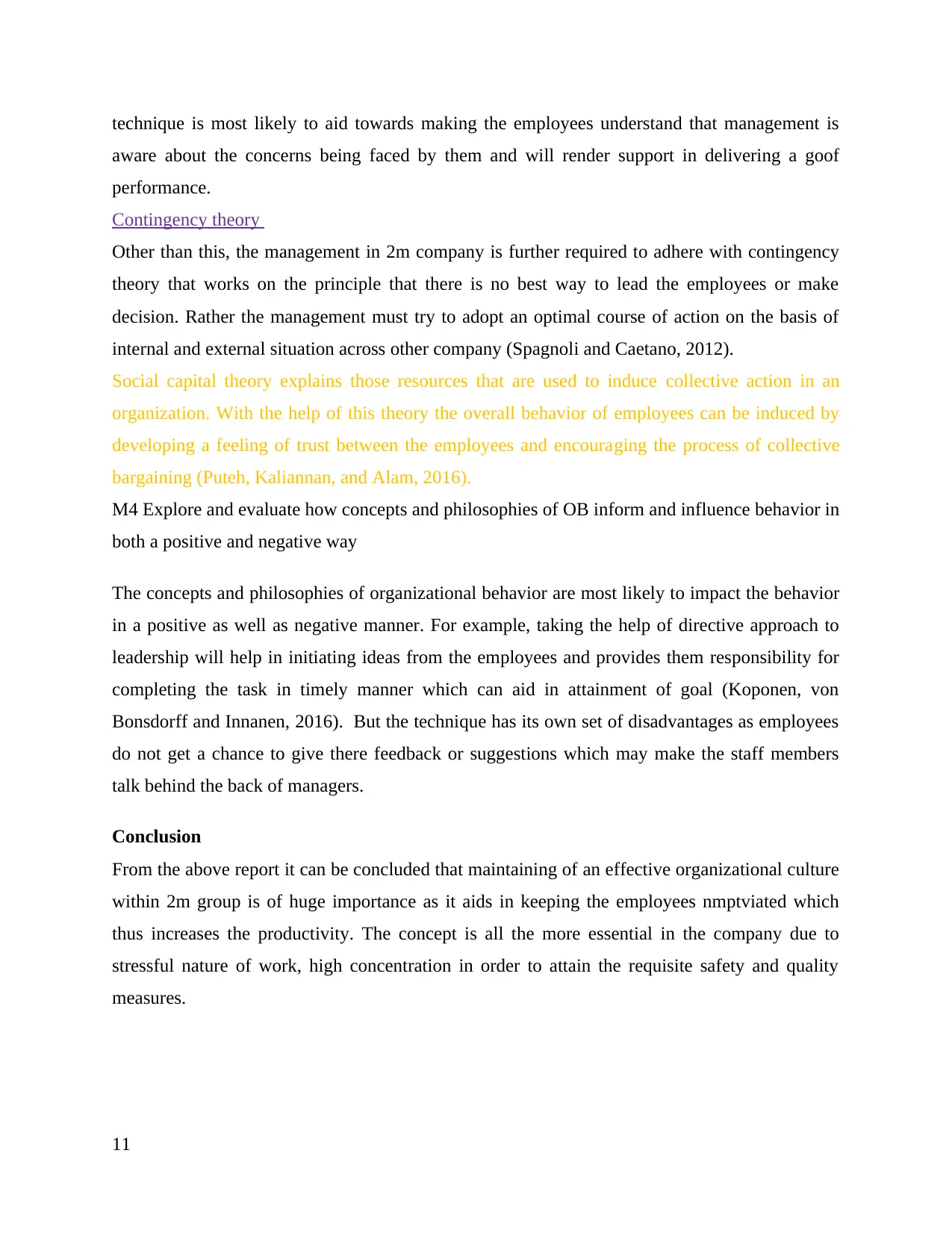
technique is most likely to aid towards making the employees understand that management is
aware about the concerns being faced by them and will render support in delivering a goof
performance.
Contingency theory
Other than this, the management in 2m company is further required to adhere with contingency
theory that works on the principle that there is no best way to lead the employees or make
decision. Rather the management must try to adopt an optimal course of action on the basis of
internal and external situation across other company (Spagnoli and Caetano, 2012).
Social capital theory explains those resources that are used to induce collective action in an
organization. With the help of this theory the overall behavior of employees can be induced by
developing a feeling of trust between the employees and encouraging the process of collective
bargaining (Puteh, Kaliannan, and Alam, 2016).
M4 Explore and evaluate how concepts and philosophies of OB inform and influence behavior in
both a positive and negative way
The concepts and philosophies of organizational behavior are most likely to impact the behavior
in a positive as well as negative manner. For example, taking the help of directive approach to
leadership will help in initiating ideas from the employees and provides them responsibility for
completing the task in timely manner which can aid in attainment of goal (Koponen, von
Bonsdorff and Innanen, 2016). But the technique has its own set of disadvantages as employees
do not get a chance to give there feedback or suggestions which may make the staff members
talk behind the back of managers.
Conclusion
From the above report it can be concluded that maintaining of an effective organizational culture
within 2m group is of huge importance as it aids in keeping the employees nmptviated which
thus increases the productivity. The concept is all the more essential in the company due to
stressful nature of work, high concentration in order to attain the requisite safety and quality
measures.
11
aware about the concerns being faced by them and will render support in delivering a goof
performance.
Contingency theory
Other than this, the management in 2m company is further required to adhere with contingency
theory that works on the principle that there is no best way to lead the employees or make
decision. Rather the management must try to adopt an optimal course of action on the basis of
internal and external situation across other company (Spagnoli and Caetano, 2012).
Social capital theory explains those resources that are used to induce collective action in an
organization. With the help of this theory the overall behavior of employees can be induced by
developing a feeling of trust between the employees and encouraging the process of collective
bargaining (Puteh, Kaliannan, and Alam, 2016).
M4 Explore and evaluate how concepts and philosophies of OB inform and influence behavior in
both a positive and negative way
The concepts and philosophies of organizational behavior are most likely to impact the behavior
in a positive as well as negative manner. For example, taking the help of directive approach to
leadership will help in initiating ideas from the employees and provides them responsibility for
completing the task in timely manner which can aid in attainment of goal (Koponen, von
Bonsdorff and Innanen, 2016). But the technique has its own set of disadvantages as employees
do not get a chance to give there feedback or suggestions which may make the staff members
talk behind the back of managers.
Conclusion
From the above report it can be concluded that maintaining of an effective organizational culture
within 2m group is of huge importance as it aids in keeping the employees nmptviated which
thus increases the productivity. The concept is all the more essential in the company due to
stressful nature of work, high concentration in order to attain the requisite safety and quality
measures.
11
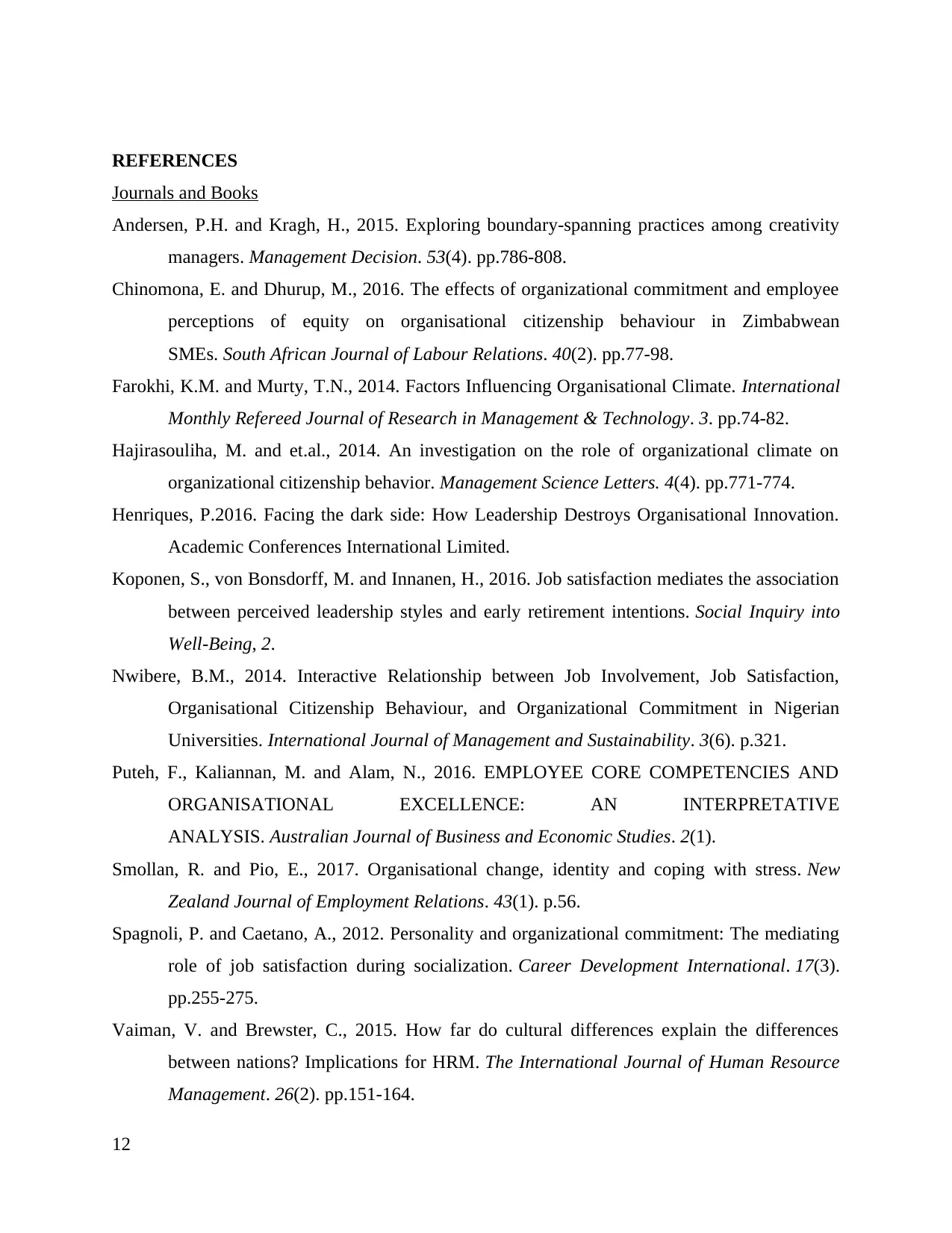
REFERENCES
Journals and Books
Andersen, P.H. and Kragh, H., 2015. Exploring boundary-spanning practices among creativity
managers. Management Decision. 53(4). pp.786-808.
Chinomona, E. and Dhurup, M., 2016. The effects of organizational commitment and employee
perceptions of equity on organisational citizenship behaviour in Zimbabwean
SMEs. South African Journal of Labour Relations. 40(2). pp.77-98.
Farokhi, K.M. and Murty, T.N., 2014. Factors Influencing Organisational Climate. International
Monthly Refereed Journal of Research in Management & Technology. 3. pp.74-82.
Hajirasouliha, M. and et.al., 2014. An investigation on the role of organizational climate on
organizational citizenship behavior. Management Science Letters. 4(4). pp.771-774.
Henriques, P.2016. Facing the dark side: How Leadership Destroys Organisational Innovation.
Academic Conferences International Limited.
Koponen, S., von Bonsdorff, M. and Innanen, H., 2016. Job satisfaction mediates the association
between perceived leadership styles and early retirement intentions. Social Inquiry into
Well-Being, 2.
Nwibere, B.M., 2014. Interactive Relationship between Job Involvement, Job Satisfaction,
Organisational Citizenship Behaviour, and Organizational Commitment in Nigerian
Universities. International Journal of Management and Sustainability. 3(6). p.321.
Puteh, F., Kaliannan, M. and Alam, N., 2016. EMPLOYEE CORE COMPETENCIES AND
ORGANISATIONAL EXCELLENCE: AN INTERPRETATIVE
ANALYSIS. Australian Journal of Business and Economic Studies. 2(1).
Smollan, R. and Pio, E., 2017. Organisational change, identity and coping with stress. New
Zealand Journal of Employment Relations. 43(1). p.56.
Spagnoli, P. and Caetano, A., 2012. Personality and organizational commitment: The mediating
role of job satisfaction during socialization. Career Development International. 17(3).
pp.255-275.
Vaiman, V. and Brewster, C., 2015. How far do cultural differences explain the differences
between nations? Implications for HRM. The International Journal of Human Resource
Management. 26(2). pp.151-164.
12
Journals and Books
Andersen, P.H. and Kragh, H., 2015. Exploring boundary-spanning practices among creativity
managers. Management Decision. 53(4). pp.786-808.
Chinomona, E. and Dhurup, M., 2016. The effects of organizational commitment and employee
perceptions of equity on organisational citizenship behaviour in Zimbabwean
SMEs. South African Journal of Labour Relations. 40(2). pp.77-98.
Farokhi, K.M. and Murty, T.N., 2014. Factors Influencing Organisational Climate. International
Monthly Refereed Journal of Research in Management & Technology. 3. pp.74-82.
Hajirasouliha, M. and et.al., 2014. An investigation on the role of organizational climate on
organizational citizenship behavior. Management Science Letters. 4(4). pp.771-774.
Henriques, P.2016. Facing the dark side: How Leadership Destroys Organisational Innovation.
Academic Conferences International Limited.
Koponen, S., von Bonsdorff, M. and Innanen, H., 2016. Job satisfaction mediates the association
between perceived leadership styles and early retirement intentions. Social Inquiry into
Well-Being, 2.
Nwibere, B.M., 2014. Interactive Relationship between Job Involvement, Job Satisfaction,
Organisational Citizenship Behaviour, and Organizational Commitment in Nigerian
Universities. International Journal of Management and Sustainability. 3(6). p.321.
Puteh, F., Kaliannan, M. and Alam, N., 2016. EMPLOYEE CORE COMPETENCIES AND
ORGANISATIONAL EXCELLENCE: AN INTERPRETATIVE
ANALYSIS. Australian Journal of Business and Economic Studies. 2(1).
Smollan, R. and Pio, E., 2017. Organisational change, identity and coping with stress. New
Zealand Journal of Employment Relations. 43(1). p.56.
Spagnoli, P. and Caetano, A., 2012. Personality and organizational commitment: The mediating
role of job satisfaction during socialization. Career Development International. 17(3).
pp.255-275.
Vaiman, V. and Brewster, C., 2015. How far do cultural differences explain the differences
between nations? Implications for HRM. The International Journal of Human Resource
Management. 26(2). pp.151-164.
12
⊘ This is a preview!⊘
Do you want full access?
Subscribe today to unlock all pages.

Trusted by 1+ million students worldwide
1 out of 13
Related Documents
Your All-in-One AI-Powered Toolkit for Academic Success.
+13062052269
info@desklib.com
Available 24*7 on WhatsApp / Email
![[object Object]](/_next/static/media/star-bottom.7253800d.svg)
Unlock your academic potential
Copyright © 2020–2025 A2Z Services. All Rights Reserved. Developed and managed by ZUCOL.





